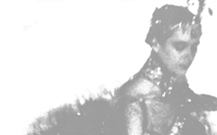Many choreographers prefer not to engage with teaching. However Matthew Hawkins is among those practitioners who embrace teaching, seeing this as an act of transference that is definitely on a par with dance making and performance. Being determined, at the threshold of his freelance paractice, to immerse himself in contemporary dance training, he developed a personal regime that he could then share. Matthew began giving open classes at
London's Pineapple Studios in 1986. His teaching has been in demand ever since.
In devising his classes Matthew's chief reference has been the form of Merce Cunningham's teaching. Hawkins experienced this method at the hand of the
master but prior to this Matthew had learned classical and modern idioms that largely opposed eachother. He found a breakthrough in the inclusiveness of Cunningham's technical formula, with its abundance of combined possibilities.
A Cunningham Technique class takes off dynamically from a standing start. A specific sequence of spinal impulses are the initial focus, these extend into activation of the limbs and notably the legs are 'worked' both turned outward and held parallel. A full range of component articulations (in variable
dynamics) are seperately practiced and then there is a selection of integrated phrases usually in three modes i.e. slow balance and extensions: rapid travelling across the studio space: combined jumping/leaping. Influenced by many other gifted teachers and referring closely to the needs of his own
physique (and those of his co-dancers, who would perform so spectacularly) Merce Cunningham skilfully balanced a contingent of consolidating exercises with a quest for extended and elevated manoeuvres. Generations of dancers have subsequently been inspired to share the activity.
|
Over more than twenty years of giving technique classes, Matthew Hawkins has adhered to Cunningham's central form but he has investigated various departures. He sees himself not so much as the guardian of a syllabus but more as an enabler to a wide community of curious folk. A degree of change, fluidity and deconstruction lends itself to the act of teaching where questions arise as to whether students actually gain some purchase or ownership regarding what is taking place. Ultimately Matthew's students cease to need him; this is a measure of his success.
Lately Matthew has been asked to give classical ballet classes to the contemporary dancers of Rambert Dance Company. In this procedure he draws upon his earliest learning experiences - these were chiefly in a system of ballet exercises known as the Cecchetti Method - named after its original Italian master teacher. The Rambert team have been struck by the compatibility in Hawkins Cecchetti-based and the Cunningham related classes which Matthew has also been giving on the premises for some time. The forms can be seen to overlap and both of them are radical on their outcomes. Yet perhaps the relevance of Hawkins' teaching resides just as much in the modes of his communicative manner as in his reflection of given movement styles.
Matthew has taught all over the UK and nearby, also in Venezuela, Japan, China, Hungary, Tunisia, Spain, Slovakia, Turkey and Siberia. He has evolved a clarity in his way of physically demonstrating dance sequences and in his methods of conveying what is required of the student - often employing minimal verbal explanation. His largely visual approach has made sense in the act of overcoming language-barriers and has also stood Hawkins in good stead when called upon to teach and compose amid those with limited theoretical skills i.e. adult beginners, actors, elders and people with learning difficulties. Amid non-specialist catchments, it has been noticable how exposure to Matthew's classes has enhanced a range of brain-into-body perceptions and fostered self-determination within the dancing. On the other hand, his students in specialised dance colleges have later excelled in important troupes. including Random, Rambert, Siobhan Davies Company, Ballet Preljocaj, Michael Clark Company and (going full-circle) the Merce Cunningham Dance Company itself.
|


